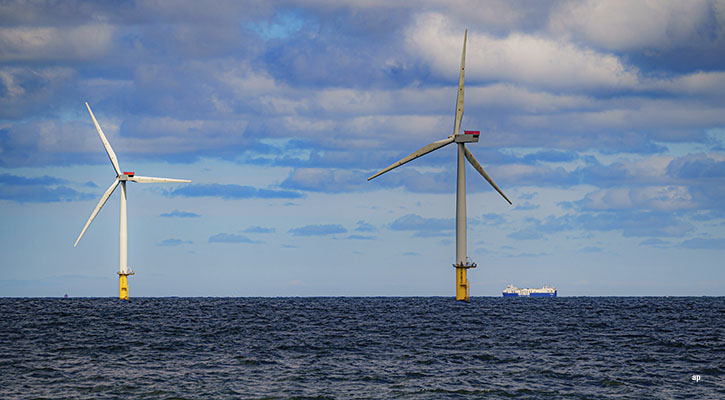
Soaring costs have derailed offshore wind projects, threatening climate change mitigation efforts and depressing valuations of wind power companies. Is it time for investors to look again at the sector?
"We see several challenges for participants in the wind energy sector. Wind turbine manufacturers have struggled to restore profitability from unprecedent cost inflation in 2021, and developers of wind projects have recorded billions in impairments due to higher equipment costs and an increase in interest rates," Matthew Donen, equity analyst at Morningstar, says.
On top of challenges within the sector, wind is losing ground to solar in terms of growth and adoption. Morningstar's senior equity analyst Tancrede Fulop says that among the European utilities companies that Morningstar covers, solar accounted for 37% of total installations in 2022, 50% in 2023 and 84% in the first quarter of 2024.
Fulop says this reflects the easing of supply chain constraints after legal changes in the US in 2022, the fall of polysilicon prices due to Chinese overcapacity and companies' strategies to combine with batteries with solar.
European Stocks Exposed to Wind Energy
- SSE (SSE)
- Ørsted (ORSTED)
- Vestas Wind Systems (VWS)
- Equinor (EQNR)
- Iberdrola (IBE)
- Enel (ENEL)
- RWE (RWE)
- E.ON (EOAN)
- Siemens (SIE)
- Schneider Electric (SU)
- TotalEnergies (TTE)
According to Tancrede Fulop, turbine prices have slightly declined in Q4 2023 and Q1 2024. On top of that, wind PPA prices have also slightly declined from their Q3 2023 peak in Europe, although they remain high at EUR 95/MWh in Q1 2024.
"Wind projects remain value-accretive despite high interest rates", he says.
The main opportunities looking ahead stem from the acceleration of the energy transition evidenced by the COP 28 conference’s goal of tripling renewable capacity by 2030, as well as high electricity demand from data centers, according to the analyst.
Denmark's Ørsted took a nosedive late September last year after ditching the development of the Ocean Wind 1 and 2 projects in the US, totalling 2.25 GW of capacity, which drove more than DKK 36 billion of impairments and cancelation fees.
"To shore up its balance sheet after these setbacks, as it has to fund future projects like the giant Hornsea 3 one, Ørsted suspended its dividend over 2023-25 and cut its growth ambitions", Tancrede Fulop explains.
Could Trump End US Wind Energy?
A favourable political environment is crucial for wind projects' success. The upcoming election in the US, where Ørsted is the leading offshore wind developer, can therefore make a big impact on the sector. Republican presidential nominee Donald Trump promised to crush offshore wind development on his first day back in office through an executive order, and told oil executives he "hates wind" in April.
"We think it would be difficult for Trump to roll back favourable tax policy for renewable energy enjoyed from the 2022 Inflation Reduction Act. A Trump administration might be able to slow implementation of the Act, but that is unlikely to slow renewable energy growth in the short-run", Matthew Donen says.
According to the equity analyst, US Congress might also be reluctant to roll back the renewable energy credits since they have generated jobs and private investment. More than half of Act-related investments benefited Republican states, according to a Financial Times analysis.
Undervalued Stocks Exposed to the Wind Sector
Among the European stocks exposed to the wind sector covered by Morningstar analysts, these are the four most undervalued right now:
Ørsted (ORSTED)
Analyst: Tancrede Fulop, CFA
- Morningstar Rating: ★★★★
- Fair Value Estimate: DKK 540.00
- Price/Fair Value: 0.73
- Economic Moat: None
- Sector: Utilities
An early mover in offshore wind, Ørsted benefited from the decline in construction costs and interest rates of the last decade while getting high subsidies. Ørsted is the leading offshore wind developer in the US, but since the end of 2021, the offshore wind industry has been hit by two material headwinds: rising construction costs and interest rates.
Ørsted is undervalued according to Morningstar's analyst, trading at a 26% discount compared to its fair value estimate of DKK 540.
"I see limited downside risk for Ørsted after the massive setbacks of 2023. The recent deals involving financial players in UK and US offshore wind reflect their strong appetite despite the woes faced by the industry since 2022. This bodes well for Ørsted’s future farm-downs. Recent auctions in New York and the hike of the ceiling price for 2024 UK offshore wind auctions show increasing political support. Ørsted would also benefit from declining interest rates", Tancrede Fulop says.
SSE (SSE)
Analyst: Tancrede Fulop, CFA
- Morningstar Rating: ★★★★
- Fair Value Estimate: GBP 22.00
- Price/Fair Value: 0.81
- Economic Moat: None
- Sector: Utilities
British energy holding company SSE is trading at a 19% discount to its fair value estimate of GBP 22. Its wholesale generation unit operates roughly 10.8 gigawatts, of which 4 GW is of hydro and wind capacity.
"We expect renewables' power generation to be the main earnings growth driver on the commissioning of 5 GW of new onshore and offshore wind net capacity in the UK through fiscal 2028. In the meantime, renewables' contribution to the group's EBIT will increase from 23% to 46% on an adjusted basis", Morningstar's analyst states.
Enel (ENEL)
Analyst: Tancrede Fulop, CFA
- Morningstar Rating: ★★★★
- Fair Value Estimate: EUR 7.50
- Price/Fair Value: 0.89
- Economic Moat: None
- Sector: Utilities
Enel is an integrated utility operating mainly in Italy, Spain, and Latin America. The grid business accounts for 35% of the group's earnings. The rest comes from generation and supply. The power generation mix is dominated by renewables, with hydro weighing 35% of the installed capacity, and solar and wind at 32%.
"The energy crisis of 2021-23 has put energy affordability at the forefront of the political agenda for European countries, increasing political risk. Spain implemented a power price cap above EUR 67/megawatt-hour for hydro and nuclear plants and a levy on energy companies' turnover. Italy implemented a cap above EUR 60/MWh for hydropower generation and suspended the system charges collection for end-users, which materially increased Enel's working capital and net debt in 2022", Tancrede Fulop states, adding:
"To shore up its balance sheet and maintain its dividend, Enel disclosed a EUR 15.2 billion asset sale plan in November 2022 that should lead the group to exit Romania, Peru, and Argentina to focus on Italy, Spain, Brazil, Chile, and Colombia. In March 2024, EUR 10.4 billion had been closed or signed in March 2024 at attractive multiples."
RWE (RWE)
Analyst: Tancrede Fulop, CFA
- Morningstar Rating: ★★★★
- Fair Value Estimate: EUR 48.00
- Price/Fair Value: 0.7
- Economic Moat: None
- Sector: Utilities
With the acquisition of Consolidated Edison's large clean-energy business in March 2023, RWE became the fourth-largest renewables firm in the US, an attractive market according to Tancrede Fulop, especially since the adoption of the Inflation Reduction Act.
"All said, nearly 80% of RWE’s EBITDA will come from wind and solar in the medium term. That means a derisked profile with more earnings and free cash flow visibility."
With its shares trading around 33.69 EUR, Tancrede Fulop views them as undervalued compared to his fair value estimate of 48.00 EUR.
"Shares sold off at the beginning of the year due to falling power prices and generation spreads, which entailed a downward revision of the guidance in January. Power prices have rebounded by 34% from the February lows and are flat year to date. Yet, RWE shares are still down by 15% since the beginning of the year. We believe that continuing strong earnings, a likely upgrade of 2024 guidance, and a pending interest-rate cut by the European Central Bank should drive a rerating of the stock", the analyst wrote in a comment dated May 15th.










:quality(80)/cloudfront-us-east-1.images.arcpublishing.com/morningstar/Q7DQFQYMEZD7HIR6KC5R42XEDI.png)






















